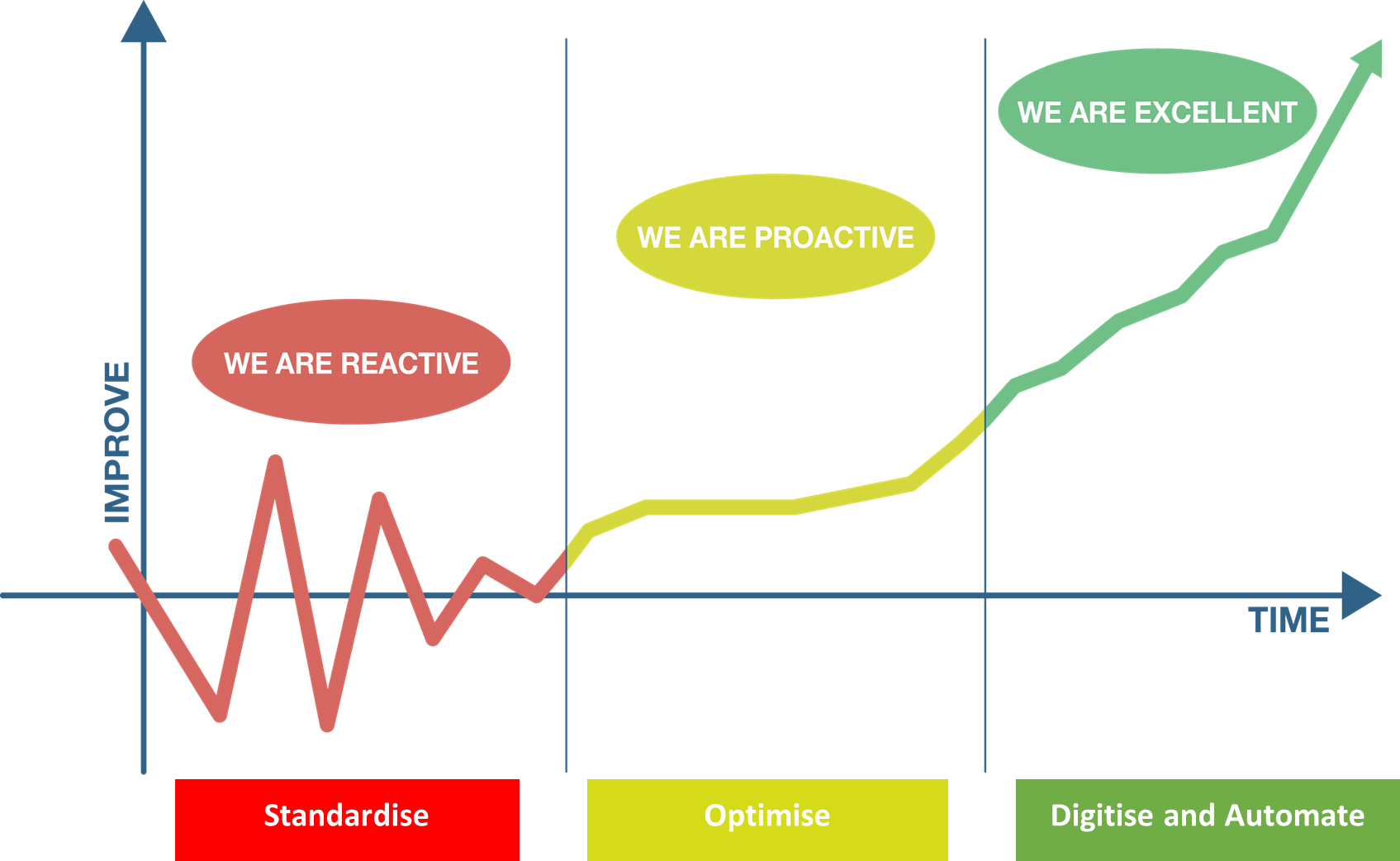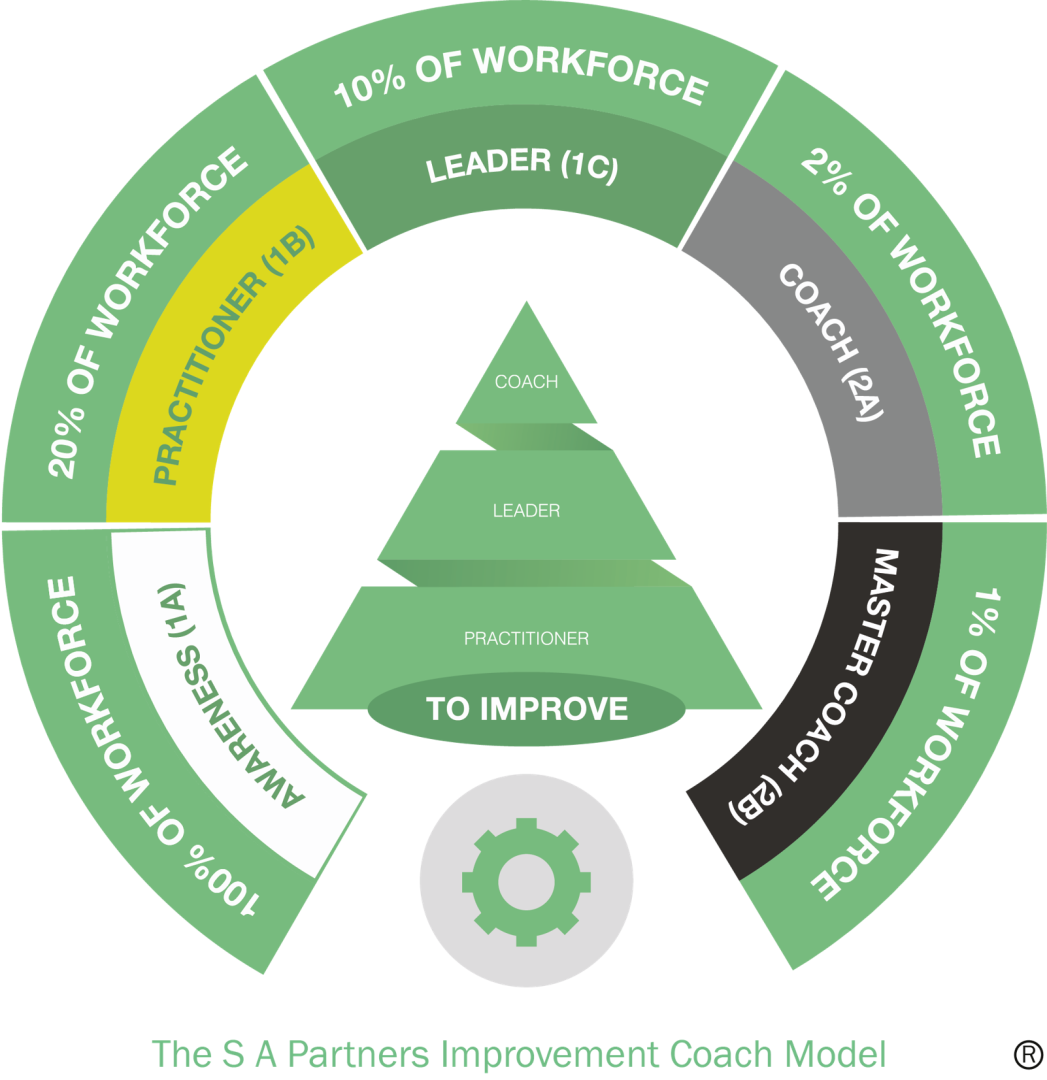We all want to improve the way that we work. Process improvement (digital or otherwise) doesn’t just happen though, someone has to drive these projects. Whose responsibility should this be? Should we ask our divisions to improve their own processes or do we create a transformation team to do it for them.
To start, let’s quickly recap S A Partner’s Improvement journey:

The model explains that to reach excellence, you need to:
- Standardise the way that work is done
- Optimise your process by removing waste
- Use technology to scale your processes
While there are more nuances, at a high level it really is that simple. The question then becomes, how, or rather who, needs to support this journey.
There are three approaches that you can take when it comes to improvement:
Centralised
Under a central model, a central team is formed of skilled and experienced people whose day job it is to deliver improvement. These central resources may be employees of the organisation itself, external consultants, or a combination of the two. The division will remain involved; however, they will be stakeholders rather than being responsible for delivering projects.
Decentralised
Under a decentralised model, the responsibility for process management and improvement will sit with the division themselves with limited, if any, central support.
Hybrid
Under a hybrid model, a central team exists however the delivery work is shared with the division. The role of the central team can vary, and be anything from providing centralised planning and oversight, all the way through to doing the lion’s share of the delivery work.
As you might imagine, there are advantages of each approach.
A centralised approach:
- Helps ensure that the quality of development is consistent and in accordance to the established standards
- Accelerates the development of solutions by providing dedicated resources
- Reduces the time and cost of development through specialisation and economies of scale
- Helps to prevent shadow IT
- Minimises the duplication of work through the creation of reusable assets
- Allows the business to focus on their day job
- Ability to implement strong governance frameworks
A de-centralised approach:
- Empowers Process Owners and Participants to improve their own processes
- May result in higher adoption from the business for solutions that they build
- Uncovers use cases that would otherwise have not been known
- Reduced the need to wait on a central team to become available
- Has lower central resource overhead requirements
Clearly then there is no one best approach. In making the decision there are a few things to consider:
- Your strategy. Is there a business benefit for your division to diverting time from their day job to work on process improvement?
- Capability. Do your people have the skills needed to successfully deliver improvement themselves?
- Capacity. Do your people have the time to be able to deliver improvement projects while continuing to perform their day job?
Again, while there is no one answer, I can offer some best practice guidance depending on the type of improvement work being done. Broadly speaking, we can split improvement work up into two arms, process management and process digitisation.
Process Management
Process Management involves documenting as-is processes, standardising the way that work is done, and improving these processes by removing waste. My recommendation is to decentralise this work.
There is a huge strategic benefit of the division doing this work – they are the ones with their boots on the ground and therefore have the best understanding of where the process can be improved, what pain-points exist, and what the root cause of the underlying issues are. I would argue that asking your team to do this work is not taking time away from their day job, it is their day job.
This of course does not mean that there is no need for a central team. You may have some large strategic projects that are too complicated to ask the division to deliver themselves, so you still should have access to central, highly skilled and experienced resources to deliver these projects as well as to support the division as they deliver projects themselves.
Having agreed that there is a strategic benefit to decentralising this work, we now need to consider capacity and capability.
Starting with capacity. There’s no point asking your divisional team to perform improvement work if they are already working at 110% utilisation. Something will need to change and overtime you need to ensure that everyone has time formally built into their performance plans to focus on improvement.
Capability is much easier. Everyone across your organisation should have some amount of process management, improvement, and problem-solving skills; the level to which will depend on the extent to which they are expected to participate and lead improvement initiatives. As a starting point, here is our guidelines for the skills required:

Process Digitisation
The second arm of process improvement is digitisation and automation. This involves using technology to improve processes which may be as anything from implementing an off the shelf tool, automating process steps, or building custom applications.
These activities do not necessarily have a strategic benefit of being performed by the division. Once we identify that our process has a step that can be automated for example, there is no strategic benefit for the division to build the automation itself. In this case, you would be better off leveraging experienced, competent professionals to perform the technical build and testing while the division focuses on their day job. There is however a benefit in the division receiving basic training on process digitisation and automation as, by understanding the art of the possible, they will then be well placed to flag where there are opportunities to incorporate technology in their processes.
In summary then, as obvious as it sounds, if you want to improve your processes you need to consider who is going to perform the improvement work. This decision needs to be anchored in strategy and supported by realistic capability and capacity planning. Finally, this decision needs to be fluid, as your organisation and the environment in which it operates evolves, so too should your execution model.
Please do reach out if you would like to discuss this in any way.
Ishan Sellahewa
moc.srentrapasobfsctd-970b82@awehalles.nahsi
